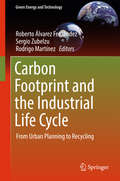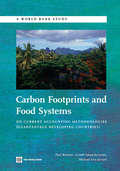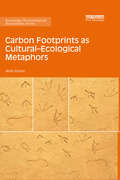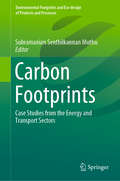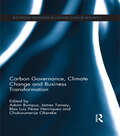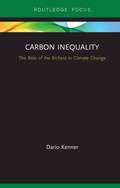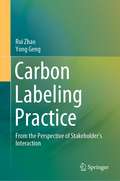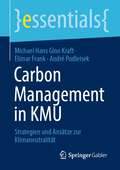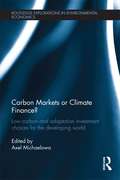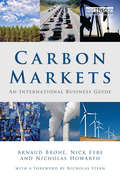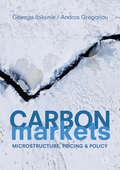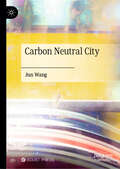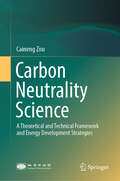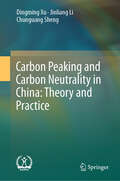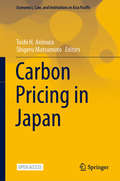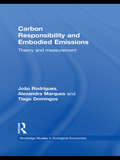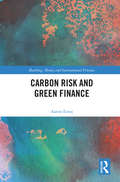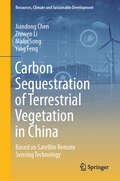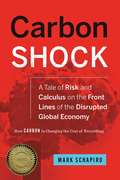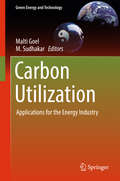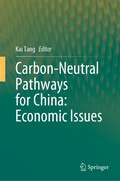- Table View
- List View
Carbon Footprint and the Industrial Life Cycle: From Urban Planning to Recycling (Green Energy and Technology)
by Sergio Zubelzu Roberto Álvarez Fernández Rodrigo MartínezThis book analyzes the relationship between large-scale industrial activity and the carbon footprint, and provides a theoretical framework and tools to calculate the carbon footprint of industrial activities at every stage of their life cycles, including urban-planning master plans, recycling activities, project and building stages as well as managing and manufacturing. Discussing the main preventative and corrective measures that can be utilized, it includes case studies, reports on technological developments and examples of successful policies to provide inspiration to readers. This book collects the contributions of authors from four continents, in order to analyze from as many as possible points of view and using many different approaches, the problem of sustainability in today's globalized world.
Carbon Footprints and Food Systems: Do Current Accounting Methodologies Disadvantage Developing Countries?
by Michael Friis Jensen Gareth Edwards-Jones Paul BrentonThis report addresses carbon labeling schemes, a high-profile issue and one that has important economic implications for developing countries. Carbon accounting and labeling instruments are designed to present information on greenhouse gas emissions (GHG) from supply chains. These instruments have become an important awareness-raising channel for governments, producers, retailers and consumers to bring about the reduction of GHGs. At the same time, they have emerged as a crucial element of supply chain management, trade logistics and, potentially, trade regulations between countries. But the underlying science of GHG emissions is only partially developed. Many of these schemes are based on rudimentary knowledge of GHG emissions and have mainly been designed by industrialized countries. There is a concern that these systems do not accurately reflect production processes in developing countries, and that they may even shift consumer preferences away from developing country exports. The report includes an analysis of current and emerging carbon labeling schemes and an assessment of available data, emissions factors and knowledge gaps of carbon footprinting methodologies. The report also analyzes carbon accounting methodologies for sugar and pineapple products from Zambia and Mauritius according to PAS 2050 guidelines, to illustrate whether these schemes accurately represent the production systems in developing countries. The report concludes with a series of recommendations on how carbon footprint labeling can be made more development-friendly
Carbon Footprints as Cultural-Ecological Metaphors (Routledge Environmental Humanities)
by Anita GirvanThrough an examination of carbon footprint metaphors, this books demonstrates the ways in which climate change and other ecological issues are culturally and materially constituted through metaphor. The carbon footprint metaphor has achieved a ubiquitous presence in Anglo-North American public contexts since the turn of the millennium, yet this metaphor remains under-examined as a crucial mediator of political responses to the urgent crisis of climate change. Existing books and articles on the carbon footprint typically treat this metaphor as a quantifying metric, with little attention to the shifting mediations and practices of the carbon footprint as a metaphor. This gap echoes a wider gap in understanding metaphors as key figures in mediating more-than-human relations at a time when such relations profoundly matter. As a timely intervention, this book addresses this gap by using insights from environmental humanities and political ecology to discuss carbon footprint metaphors in popular and public texts. This book will be of great interest to researchers and students of environmental humanities, political ecology, environmental communication, and metaphor studies.
Carbon Footprints: Case Studies from the Energy and Transport Sectors (Environmental Footprints and Eco-design of Products and Processes)
by Subramanian Senthilkannan MuthuThis book presents revealing case studies on carbon footprint calculation and mitigation in various industrial sectors. There are numerous sectors whose carbon footprints need to be calculated, and effective ways to mitigate the greenhouse-gas emissions from these sectors need to be found. Using representative case studies, this book highlights the carbon footprint of national power generation systems, crude glycerol production plants and the Brazilian highway network system, as well as the integration of renewable energy sources in expansion planning, so as to promote and implement power system decarbonization.
Carbon Footprints: Methods and Calculations
by Michael W. Toffel Stephanie Van SiceDescribes methods to calculate the carbon footprint (greenhouse gas emissions) of an organization's operations and supply chain, and a product or service. Illustrates concepts with examples of calculating the carbon footprint of an organization (Harvard Business School) and a product (a newspaper). Provides data necessary for carbon footprint calculations.
Carbon Footprints: Methods and Calculations
by Michael W. Toffel Stephanie Van SiceDescribes methods to calculate the carbon footprint (greenhouse gas emissions) of an organization's operations and supply chain, and a product or service. Illustrates concepts with examples of calculating the carbon footprint of an organization (Harvard Business School) and a product (a newspaper). Provides data necessary for carbon footprint calculations.
Carbon Governance, Climate Change and Business Transformation (Routledge Advances in Climate Change Research)
by Blas Luis Pérez Henríquez James Tansey Adam Bumpus Chukwumerije OkerekeTransformation to a low carbon economy is a central tenet to any discussion on the solutions to the complex challenges of climate change and energy security. Despite advances in policy, carbon management and continuing development of clean technology, fundamental business transformation has not occurred because of multiple political, economic, social and organisational issues. Carbon Governance, Climate Change and Business Transformation is based on leading academic and industry input, and three international workshops focused on low carbon transformation in leading climate policy jurisdictions (Canada, USA and the UK) under the international Carbon Governance Project (CGP) banner. The book pulls insights from this innovative collaborative network to identify the policy combinations needed to create transformative change. It explores fundamental questions about how governments and the private sector conceptualize the problem of climate change, the conditions under which business transformation can genuinely take place and key policy and business innovations needed. Broadly, the book is based on emerging theories of multi-levelled, multi-actor carbon governance, and applies these ideas to the real world implications for tackling climate change through business transformation. Conceptually and empirically, this book stimulates both academic discussion and practical business models for low carbon transformation.
Carbon Inequality: The Role of the Richest in Climate Change (Routledge Focus on Environment and Sustainability)
by Dario KennerWith a specific focus on the United States and the United Kingdom, Carbon Inequality studies the role of the richest people in contributing to climate change via their luxury consumption and their investments. In an innovative contribution, it attempts to quantify personal responsibility for shareholdings in large fossil fuel companies. This book explores the implications of the richest people’s historic responsibility for global warming, the impacts of which affect them less than most others in global society. Kenner analyses how the richest people running large oil and gas companies have successfully used their political influence to lobby the US and UK government. This assessment of their growing political power is particularly pertinent at a time of increasing inequality and growing public awareness of the impact of climate change. The book also highlights the crucial role of the richest in blocking the low-carbon transition in the US and the UK, exploring how this could be countered to ensure fossil fuels are fully replaced by renewable energy. This book will be of great relevance to scholars and policy makers with an interest in inequality, climate change and sustainability transitions.
Carbon Labeling Practice: From the Perspective of Stakeholder’s Interaction
by Rui Zhao Yong GengThis book focuses on the behavioral interactions among possible stakeholders in carbon labeling practice, brings the attentions of stakeholders’ interests to explore the opportunities, and challenges related to carbon labeling practice, thus to provide insight into low-carbon consumption and production. It is essential reading for students, researchers, and policy makers as well as those with a wider interest in environmental science and sustainable development.
Carbon Management in KMU: Strategien und Ansätze zur Klimaneutralität (essentials)
by Michael Hans Kraft Elimar Frank André PodleisekCarbon Management bezeichnet einen systematischen Ansatz zur Erfassung, Messung und Reduzierung von CO2-Emissionen in Unternehmen. Es umfasst sowohl strategische als auch operative Maßnahmen, die darauf abzielen, den ökologischen Fußabdruck zu verringern und gleichzeitig unternehmerische Vorteile zu realisieren. Während multinationale Unternehmen sich bereits mit ihrer Umweltverantwortung auseinandersetzen, stehen viele kleine und mittlere Unternehmen (KMU) erst am Anfang, obwohl sie eine entscheidende Rolle bei der Erreichung der Klimaneutralität spielen. Unter Berücksichtigung der spezifischen Anforderungen für KMU werden in diesem essential die strategischen und operativen Herausforderungen zur Umsetzung eines klimaneutralen Geschäftsmodells diskutiert und konkrete Maßnahmen zur Implementierung vorgestellt.
Carbon Management: A WORKSHOP REPORT TO THE CHEMICAL SCIENCES ROUNDTABLE
by Chemical Sciences RoundtableA report on Carbon Management
Carbon Markets or Climate Finance: Low Carbon and Adaptation Investment Choices for the Developing World (Routledge Explorations In Environmental Economics Ser. #34)
by Axel MichaelowaThis book builds on a decade-long experience with mechanisms provided by the Kyoto Protocol and the UN Framework Convention on Climate Change. It discusses the challenges of climate finance in the context of the post-Copenhagen negotiations and provides a long-term outlook of how climate finance in developing countries could develop. Written by climate finance experts from academia, carbon finance businesses and international organisations, the book provides background, firsthand insights, case studies and analysis into the complex subject area of climate finance.
Carbon Markets: An International Business Guide (Environmental Market Insights)
by Nick Eyre Arnaud Brohé Nicholas HowarthWinner of the Choice Outstanding Academic Titles of 2010 award. This book is a comprehensive and accessible guide to understanding the opportunities offered by regulated and voluntary carbon markets for tackling climate change. Coverage includes: - An overview of the problem of climate change, with a concise review of the most recent scientific evidence in different fields - A highly accessible introduction to the economic theory and different constitutive elements of a carbon allowances market - Explanation of the Kyoto Protocol and its flexibility mechanisms - Explanation of how the EU Emissions Trading Scheme works in practice - Ongoing developments in regulated carbon markets in the US - Up-to-the-minute coverage of regulated carbon markets in Australia - Developments in New Zealand and Japan - Carbon offsetting and voluntary carbon markets. Combining theoretical aspects with practical applications, this book is for business leaders, financiers, carbon traders, lawyers, bankers, researchers, policy makers and anyone interested in market mechanisms to mitigate climate change. The carbon emissions resulting from the production of this book have been calculated, reduced and offset to render the bookcarbon neutral.
Carbon Markets: Microstructure, Pricing And Policy
by Gbenga Ibikunle Andros GregoriouThis book explores the microstructure of carbon markets and the pricing of carbon financial instruments generally. It provides a critical microstructure analysis of the EU Emissions Trading Scheme (EU-ETS), and also examines the theoretical and related market design issues affecting emissions trading schemes. Individual chapters analyse how intraday pricing evolves in carbon markets, the price impact of block trades in carbon financial instruments and their determinants, short and long-term liquidity effects in carbon markets, and the links between carbon market liquidity and efficiency. The aforementioned issues are explored using case studies of two major trading platforms operating within the EU-ETS. The book concludes by focusing on future policy and regulatory challenges in carbon markets, especially with respect to addressing pricing volatility challenges.
Carbon Neutral City
by Jun WangThis book introduces the ecological, low-carbon, and sustainable concept of ideal cities from different views. With beliefs and practices of scholars in the past in pursuit of ideal cities, it is written with historical events in the development of low-carbon cities. In this way, activities about carbon peaking and carbon neutrality happening worldwide at present can be shown, and efforts variety countries have paid off can be exhibited. Besides, as for the centralized and the distributed space structure in urban evolution, the book discusses their trends and comes up with an ideal model, the distributed city, to realize carbon neutrality based on the distributed structure. Therefore, with a practical example in planning, the feasibility of the distributed city is analyzed in several fields, including space, energy, traffic, water, waste disposal, etc. The book can be used as materials for professionals in city planning and construction, low-carbon development and other fields, as well as a way for ordinary people to learn about the complex city.
Carbon Neutrality Science: A Theoretical and Technical Framework and Energy Development Strategies
by Caineng ZouThis book focuses on the connotation and extension of carbon neutrality. It presents a full collection of various topics in carbon neutrality, including carbon production, reduction, utilization, storage, capture, markets, and society, etc. It concludes that carbon neutrality is the pathway to global green and low-carbon sustainable development and the foundation for building harmonious ecological civilization. This book is a valuable reference for researchers, practitioners, and policy-makers in the field of earth and environmental sciences.
Carbon Peaking and Carbon Neutrality in China: Theory and Practice
by Dingming Xu Jinliang Li Chunguang ShengChina has made a major strategic decision to achieve carbon peak before 2030 and carbon neutrality by 2060. The country has formulated a clear timetable, roadmap, and construction plan and introduced the “1+N” policy system from the top. This book provides a theoretical study and practical exploration of nine key aspects related to China's carbon peaking and carbon-neutral strategy: the background of Carbon Peaking and carbon neutrality, scientific and legal basis, strategic planning and path framework, energy-saving and carbon reduction measures, renewable energy, carbon sinks, carbon pricing mechanisms, the green financial system, and practical case studies.The translation was done with the help of artificial intelligence. The present version has been revised technically and linguistically by the authors in collaboration with a professional translator.
Carbon Pricing in Japan (Economics, Law, and Institutions in Asia Pacific)
by Toshi H. Arimura Shigeru MatsumotoThis open access book evaluates, from an economic perspective, various measures introduced in Japan to prevent climate change. Although various countries have implemented such policies in response to the pressing issue of climate change, the effectiveness of those programs has not been sufficiently compared. In particular, policy evaluations in the Asian region are far behind those in North America and Europe due to data limitations and political reasons.The first part of the book summarizes measures in different sectors in Japan to prevent climate change, such as emissions trading and carbon tax, and assesses their impact. The second part shows how those policies have changed the behavior of firms and households. In addition, it presents macro-economic simulations that consider the potential of renewable energy. Lastly, based on these comprehensive assessments, it compares the effectiveness of measures to prevent climate change in Japan and Western countries.Providing valuable insights, this book will appeal to both academic researchers and policymakers seeking cost-effective measures against climate change.
Carbon Responsibility and Embodied Emissions: Theory and Measurement (Routledge Studies In Ecological Economics Ser.)
by João F. Rodrigues Tiago M. Domingos Alexandra P.S. MarquesClimate change policy and the reduction of greenhouse gas emissions are currently discussed at all scales, ranging from the Kyoto Protocol to the increasingly frequent advertisement of ''carbon neutrality'' in consumer products. However, the only policy option usually considered is the reduction of direct emissions. Another potential policy tool, currently neglected, is the reduction of indirect emissions, i.e., the emissions embodied in goods and services, or the payments thereof. This book addresses the accounting of indirect carbon emissions (as embodied in international trade) within the framework of input-output analysis and derives an indicator of environmental responsibility as the average of consumer and producer responsibility. A global multi-regional input-output model is built, using databases on international trade and greenhouse gas emissions, from which embodied carbon emissions and carbon responsibilities are obtained. Carbon Responsibility and Embodied Emissions consists of a theoretical part, concerning the choice of environmental indicators, and an applied part, reporting an environmental multi-regional input-output model. It will be of particular interest to postgraduate students and researchers in Ecological Economics, Environmental Input-Output Analysis, and Industrial Ecology.
Carbon Risk and Green Finance (Banking, Money and International Finance)
by Aaron EzrojAs the world plans for economic recovery following the global COVID-19 pandemic, major economies are looking to comprehensive strategies for addressing carbon risks and identifying green finance opportunities. Since Bank of England Governor Mark Carney and Michael Bloomberg began tackling climate change as a financial concern, the international financial community has been developing sophisticated analytical tools that will enable the success of comprehensive efforts to address carbon risks and identify green finance opportunities. This timely publication offers a cutting-edge analysis of the financial aspects of climate change. It discusses the most important analytical tools, their origin, how they work, where they can go, and how they fit into a larger strategy. First, reporting frameworks can allow companies to see how well they are addressing carbon risks, in particular with respect to the recommendations of the Task Force on Climate-related Financial Disclosures. Second, by quantifying how much greenhouse gas companies emit into the atmosphere as a direct or indirect result of their operations, carbon footprint calculations can help identify carbon risks with particular companies, especially within supply chains. Third, brown taxonomies can help investors identify current carbon risks by classifying fossil fuel assets in a systematic manner. Fourth, green taxonomies can help investors identify current green finance opportunities by classifying sustainable activities in a systematic manner. Fifth, scenario analysis for assets can help investors identify future carbon risks and green finance opportunities. Finally, stress testing for liabilities can help insurers and banks address future carbon risks and better inform policymakers. Scholars, policymakers, and business professionals will find this book informative. They will gain a comprehensive understanding of the analytical tools supporting efforts to address carbon risks and identify green finance opportunities. This will hopefully make these individuals more successful in their personal endeavors to build a more sustainable and resilient economy for future generations.
Carbon Sequestration of Terrestrial Vegetation in China: Based on Satellite Remote Sensing Technology (Resources, Climate and Sustainable Development)
by Malin Song Jiandong Chen Zhiwen Li Ying FengThis book estimates terrestrial vegetation carbon sequestration data based on remote sensing satellite data, collects the temporal and spatial characteristics of carbon sequestration by vegetation at county level and grid scale in China, and predicts the future change of carbon sequestration by vegetation in China. Based on the major strategic development goals and specific practices of China's carbon neutrality, this book shifts the research perspective from the side of carbon reduction to the weaker side of carbon sequestration. It not only broadens and enriches the research boundaries and theoretical connotation in the field of carbon neutrality, but also provides a perspective reference for further research on carbon sequestration by vegetation, which has pioneering academic value for future research on carbon dioxide. The satellite data is collected to calculate China's long time series and multi-type district and county vegetation carbon sequestration data set, which can meet different research needs and application scenarios. The practical value lies in providing basic data for the research of carbon neutrality, the establishment of carbon trading market and the calculation of vegetation carbon sink, and providing an important reference index for evaluating the ecological and environmental effects of land change. This book combines remote sensing technology, Geographic Information Science (GIS), spatial visualization technology and index decomposition technology to measure vegetation carbon sequestration in counties and districts of China, reveals the spatial-temporal dynamic change process of vegetation carbon sequestration, and explores the driving influence of social factors.
Carbon Shock
by Mark SchapiroAs the world moves toward making more and more polluters pay to emit carbon, a financial mystery unfolds: What are the costs? Who has the responsibility to pay for them? Who do you pay? How do you pay? And what are the potential impacts? These are the questions veteran journalist Mark Schapiro attempts to answer as he illuminates the struggle to pinpoint carbon’s true costs and allocate them fairly—all while bumping up against the vagaries of the free market, the lobbying power of corporations, the political maneuverings of countries, and the tolerance of everyday consumers buying a cup of coffee, a tank of gas, or an airplane ticket. Along the way, Schapiro tracks the cost of carbon through the drought-ridden farmland of California, where higher temperatures are driving up the price of the food we eat, the prices farmers pay for crop insurance, and the impact on taxpayers. Through the jungles of Brazil, where foreign polluters pay to keep trees standing—as offsets to absorb CO2—at a fraction of the cost they are worth to the struggling communities around them, who engage in logging or other uses. Through the world's greatest manufacturing center, asking who should pay for the pollution generated there—the Chinese who operate the factories or the Westerners who consume the goods they produce? Through the skies, where recent efforts to put a price tag on the carbon left by airplanes in the no-man's land of the atmosphere created what amounted to a quiet but powerful global trade war. Through the carbon-trading capital of Europe, where economists try to establish a price for a bizarre new commodity—a ton of carbon that will not be emitted—literally selling the air in an effort to curtail emissions. And, finally, through the high-tech crime world the new carbon markets have inspired, and the emerging nations that—as they amp up manufacturing, put more cars on their streets, and up their consumption—teeter on the brink of this wild, new carbon economy. For almost two decades, the primary topic of global climate negotiations has been to find a way to pay for the costs of carbon, slow greenhouse gas emissions, and stimulate a shift away from fossil fuels in order to shrink the earth’s carbon footprint. The key tool to date—the international carbon trade—has foundered in a sea of questions deftly explored by Schapiro, and in the turmoil of a global recession. As we approach the next climate negotiations in 2015, will nations stick to business as usual? Or will the world come to terms with the real price for carbon, and figure out a sensible way to pay for it?
Carbon Taxes: Their Macroeconomic Effects and Prospects for Global Adoption--A Survey of the Literature
by Ved P. Gandhi Javier CuervoA report from the International Monetary Fund.
Carbon Utilization: Applications for the Energy Industry (Green Energy and Technology)
by M. Sudhakar Malti GoelThis book provides in-depth information on topics relating to anthropogenic carbon dioxide utilization processes. Presenting a collection of state-of-the-art scientific reviews and research perspectives on carbon management strategies of relevance to the energy industry, it features contributions by leading scientists and technocrats across 19 chapters as an Indian contribution In the energy industry, new processes for carbon dioxide removal and recycling are developing quickly, and it is in this context that the book provides an opportunity to review the current status of and promote efforts to achieve effective carbon capture and management. The contents presented here will prove useful to researchers, students, industry experts, scientists and policymakers alike.
Carbon-Neutral Pathways for China: Economic Issues
by Kai TangThis book provides comprehensive economic analyses on the paths to net-zero for China. It gives a detailed overview of issues and challenges related to carbon neutrality of the global largest emitter which have not been adequately addressed e.g., reduction costs and efficiency of existing actions, the multiple impacts of the newly established carbon market, and the potentials and costs of nature-based solutions such as biophysical sequestration, etc. Studies on China’s carbon reduction have attracted scientists and policymakers from diverse backgrounds. Pursuing a holistic and systematic approach, the book establishes a fundamental framework for this topic, emphasizing the importance of integrated technical-economic-policy analysis. This book will not only be an essential reference to the carbon-neutral progress in China but also will be an outstanding text book on carbon-neutral management. Similarly, this book is expected to attract a great range of readership including undergraduate and postgraduate students, economic and climate specialists, researchers and policymakers in China as well as in overseas.
